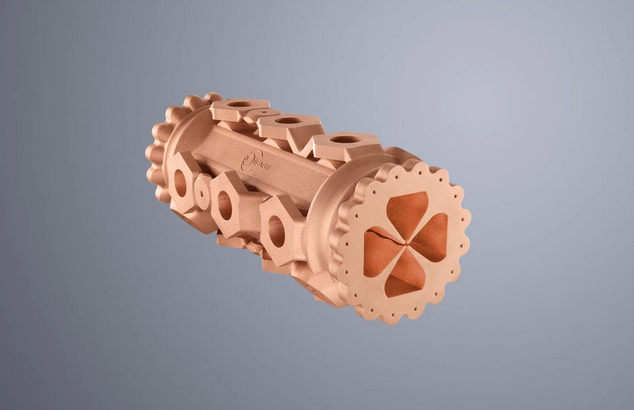First additively manufactured accelerator component made of pure copper // Highest quality for core component of particle accelerators // Green laser shows its advantages with copper // Presentation at Formnext
The high-tech company TRUMPF has for the first time additively manufactured a core component of future particle accelerators as part of the I.FAST project, which is funded by the EU and coordinated by CERN. The special thing about it: for the first time, it has been possible to print this critical copper component in one piece. "This is proof that users can additively manufacture large copper components with a component height of almost 400 millimetres with great precision using our machines - or in other words: with 3D printing, we can also manufacture high-precision parts like this faster, more cost-effectively and more energy-efficiently," says Michael Thielmann, additive manufacturing expert at TRUMPF. The high-tech company will show the particle accelerator component at the leading 3D printing trade fair Formnext in Frankfurt.
It is a so-called radio frequency quadrupole (RFQ), one of the most complex parts of an accelerator complex. The RFQ accelerates the particle beam, bringing it almost to the speed of light. "There are currently over 30,000 accelerators in use worldwide, most of them in healthcare and industry. Additive manufacturing can help reduce the size and cost of all types of accelerators by improving and shortening their manufacture, and increasing their performance," says Maurizio Vretenar of CERN, project coordinator of I.FAST.
CERN investigates the benefits of additive manufacturing
The additively manufactured RFQ is part of the I.FAST (Innovation Fostering in Accelerator Science and Technology) project, funded by the EU and coordinated by CERN. The aim of the strategic project is to give Europe a leading role in particle accelerators for science and society, or to expand this role. Among other things, the focus is on 3D metal printing. "It is obvious that in the future we will increasingly use additively manufactured components in the accelerator community and in our facilities," says Toms Torims from Riga University of Technology, who coordinates the I.FAST work package for advanced accelerator technologies.
Highest quality thanks to green laser
The I.FAST team of experts from CERN, Politecnico de Milano, CNRS-IN2P3, Fraunhofer IWS and the Technical University of Riga developed the complex component especially for TRUMPF's TruPrint 5000 Green Edition. The RFQ has very high requirements for the manufacturing process. "This is where our TruPrint 5000 Green Edition comes into play. Thanks to the green laser, we can print even the finest copper structures in high and consistent quality while increasing productivity," says Thielmann.
Faster production lowers component costs
Until now, suppliers manufactured RFQs for scientific laboratories such as CERN and for industry using conventional methods. Many individual production steps such as milling and soldering were necessary. This costs time and money. With additive manufacturing, many intermediate steps are eliminated. For example, the TRUMPF system can print cavities such as cooling channels at the same time. "With our green laser, we are also faster in the additive manufacturing of copper components than comparable systems with infrared technology," says Thielmann. The copper absorbs the green laser beam better than that of an infrared laser, making it easier to process. "We need less energy to be as fast as an infrared laser, or we can work faster with the same energy," says Thielmann. As a result, users can additively manufacture copper components more cost-effectively with the green laser.
www.trumpf.com

 Deutsch (Germany)
Deutsch (Germany)  Polski (PL)
Polski (PL) 









